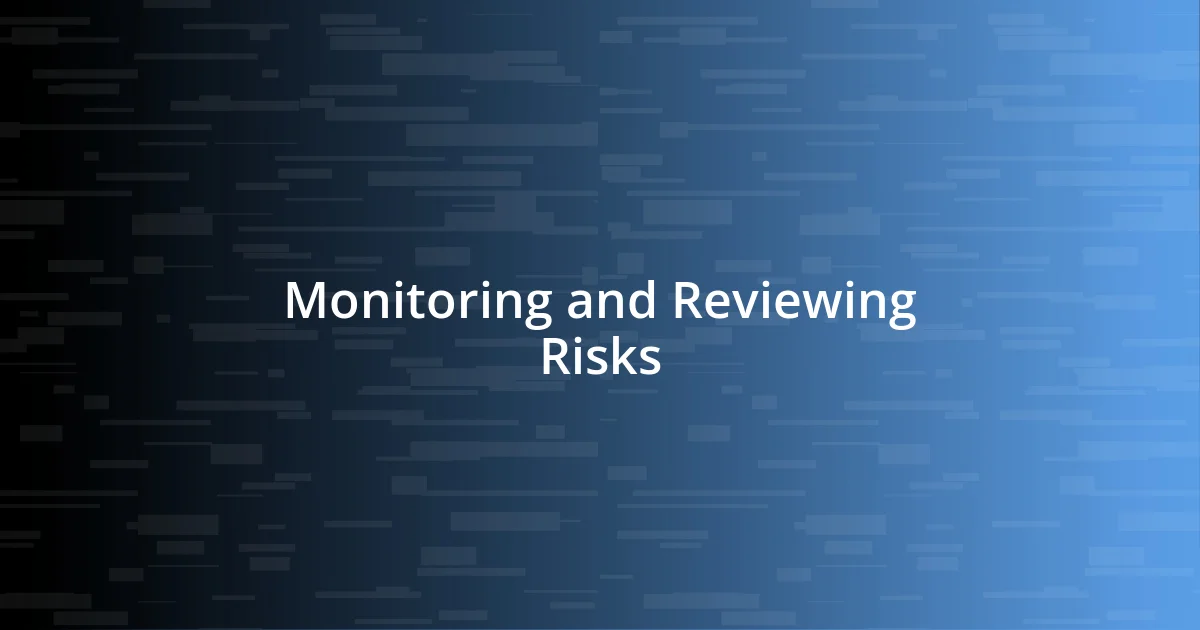Key takeaways:
- Effective risk management involves continuous monitoring, assessment, and adaptation to evolving risks, enhancing project resilience and decision-making.
- Collaboration is crucial; engaging diverse team members in risk identification and discussion fosters ownership and reveals blind spots.
- Clear communication and visual tools, such as risk maps, improve understanding and engagement, making risk management a collective effort.

Understanding Risk Management Principles
Risk management is fundamentally about understanding uncertainties and their potential impacts. I remember when I first started working in project management; we faced unexpected challenges that taught me the importance of assessing risks early on. Can you imagine the relief of having a plan in place before a crisis hits?
At its core, risk management revolves around identifying, analyzing, and mitigating risks. I’ve seen firsthand how a simple risk assessment can pave the way for better decision-making. For example, while leading a team on a tight deadline, we identified potential pitfalls in our schedule that we could address proactively. It felt empowering to turn what could have been a disaster into an opportunity for growth.
One principle that stands out to me is the need for continuous monitoring and review. After a project launch, I learned that risks can evolve, just like our strategies. It made me wonder: how often do we revisit our risk management plans? The answer, I believe, should be often. In my experience, staying vigilant allows us to adapt and thrive, even in unpredictable environments.

Identifying Potential Risks Effectively
Identifying potential risks effectively starts with cultivating a mindset that views uncertainty as an opportunity rather than a threat. I recall a time when I was involved in a crucial marketing launch; we spent hours brainstorming every conceivable risk. It was invigorating to see the team rally together, and by documenting our concerns, we not only prepared for hurdles but also strengthened our bond. Gaining insights from diverse perspectives made us more resilient and open to tackling challenges head-on.
To streamline the identification process, consider these steps:
– Conduct Brainstorming Sessions: Gather your team to compile a comprehensive list of risks.
– Review Historical Data: Look back at previous projects to identify patterns or recurring issues.
– Engage Stakeholders: Include insights from team members across various departments to uncover blind spots.
– Utilize Checklists: Create a specific checklist tailored to your project’s unique characteristics.
– Leverage Analytical Tools: Use software or methodologies (like SWOT analysis) to assess risks systematically.

Analyzing Risks and Impacts
Analyzing risks and impacts is a crucial step in risk management. I remember a particular project where we had to analyze potential impacts on our budget and timeline. By creating a detailed risk matrix, we were able to assign probabilities and prioritize risks based on their potential severity. It was eye-opening how visualizing risks in this way not only clarified priorities but also fostered better communication among team members.
Impact analysis isn’t just about numbers; it involves understanding how those risks affect both the project and the people involved. I have experienced moments when a seemingly small risk, like a missing stakeholder’s input, could snowball into significant delays. This realization reinforced my belief that every team member’s perspective is valuable; their insights can reveal impacts I might have otherwise overlooked.
In practice, quantifying risks and impacts can lead to informed decision-making. For instance, when assessing the risk of resource availability during peak times, we realized we needed to adjust our timelines to mitigate potential bottlenecks. This proactive approach saved us time and stress, proving that investing effort upfront into analysis pays off later on.
| Risk Type | Potential Impact |
|---|---|
| Financial | Budget overruns, decreased profitability |
| Reputational | Loss of customer trust, negative publicity |
| Operational | Delays in project delivery, resource allocation issues |
| Regulatory | Potential fines, legal implications |

Developing Risk Mitigation Strategies
Developing effective risk mitigation strategies is where we translate our risk analysis into actionable plans. I often think back to a software development project that felt like a labyrinth of potential pitfalls. By breaking down each identified risk and brainstorming specific response strategies, we created a robust action plan. What I found inspiring was how this approach sparked creativity within the team—together, we came up with innovative solutions that transformed our vulnerabilities into stepping stones for success.
One tactic I’ve found invaluable is establishing clear contingency plans for our top risks. For instance, I remember a time when a key vendor unexpectedly fell through, jeopardizing our timeline. Thankfully, we had a backup vendor already vetted. I can’t help but wonder how many teams operate without this safety net. Having alternatives in place not only protects us from unforeseen disruptions but also provides peace of mind, fostering a more resilient team dynamic.
Moreover, communication plays a vital role in implementing these strategies. I’ve experienced the power of regular check-ins to reassess risks and adapt mitigation tactics as needed. It’s almost like a living document that grows with the project. How often do we underestimate the value of keeping everyone in the loop? These conversations ensure that every team member feels accountable and empowered to contribute to solutions, making our risk management process not just a task, but a cohesive, collaborative effort.

Implementing Risk Management Plans
Implementing risk management plans requires diligent execution and continuous monitoring. I recall a particularly stressful project where I took the lead in making sure our risk management strategies were not just drafted but actively implemented. It became evident that we could not afford to treat these plans as mere paperwork; daily stand-up meetings helped us track progress and adapt to changes in real time.
One striking moment for me was when a minor risk suddenly escalated because we hadn’t communicated effectively. A team member mentioned that they were behind schedule due to personal commitments, which, if unaddressed, could lead to a cascading effect on our timeline. So, incorporating open lines of communication and regular check-ins transformed our plan from a static document into a living guide that genuinely influenced our project’s direction.
To put this into practice, I emphasize the importance of assigning clear roles and responsibilities within the risk management framework. Once, during a high-stakes initiative, I assigned specific risks to team members based on their areas of expertise. This move not only fostered a sense of ownership but also brought diverse perspectives to the table. I think back to that experience and realize how empowering it was for everyone involved; it’s remarkable how accountability can fuel collaboration and drive success.

Monitoring and Reviewing Risks
Monitoring and reviewing risks is a crucial step in ensuring that our risk management strategies remain effective over time. I can recall a significant moment during a marketing campaign launch. As we gathered feedback post-launch, it became clear that we had not only missed some potential risks but also failed to address them promptly. This experience underscored for me the importance of ongoing vigilance – risks can evolve, and we must evolve with them.
One key method I’ve embraced is setting up a regular risk review cycle, which can be incredibly insightful. During one project, we implemented bi-weekly reviews, and I vividly remember a discussion that revealed a brewing issue concerning our customer feedback loop. By simply dedicating some time to reflect and assess our current standing, we were able to pivot and refine our strategy before it became a significant setback. Isn’t it fascinating how regular touchpoints can sometimes lead to significant breakthroughs in our understanding of risk?
Additionally, I’ve learned that involving team members in the monitoring process cultivates a culture of awareness and proactive problem-solving. I once brought our whole team together for a “risk review brainstorming session.” It was a bit unconventional, but the ideas flowed like a waterfall; everyone contributed potential risks they perceived from their unique perspectives. This experience not only revealed hidden risks but also created a stronger bond within the team. Isn’t it great how creating a space for open dialogue can lead to collective ownership and responsibility in managing risks?

Communicating Risk Management Processes
Communicating risk management processes is essential for fostering a cohesive understanding among all team members. I recall a project where I decided to host a workshop specifically focused on risk awareness. During this session, we broke down complex terminologies and processes into relatable examples that everyone could connect with. It was remarkable to see the collective “aha” moments as team members realized how they individually fit into the broader risk landscape. Doesn’t it feel more reassuring when we all speak the same language?
Moreover, I’ve found that creating visual representations of risk processes can make a significant impact. For instance, I once designed a simple risk map that highlighted probabilities and potential impacts for our team. Seeing these risks laid out visually sparked great discussions and made abstract concepts much more tangible. How often do we overlook the power of visual aids to enhance comprehension and engagement?
Finally, authentic, two-way communication plays a pivotal role. In one instance, I implemented a feedback loop where team members could voice concerns or insights regarding risks in real-time. This openness not only made everyone feel valued but also encouraged a proactive approach to risk identification. It’s fascinating how cultivating an environment where questions and discussions are welcomed leads to a more resilient team. Have you noticed how often the right questions can unlock new solutions?














